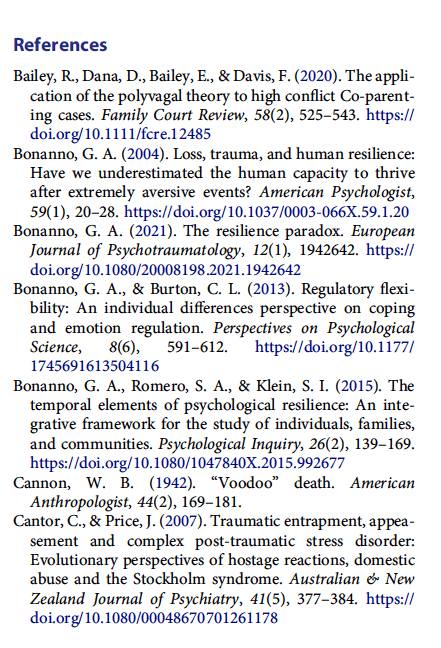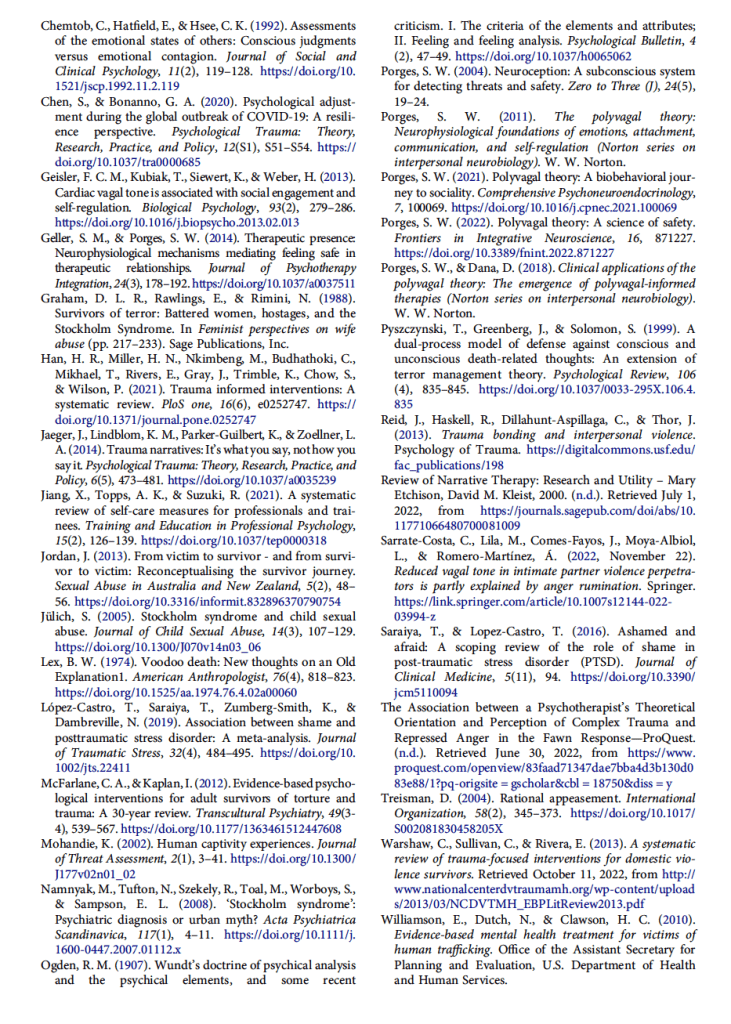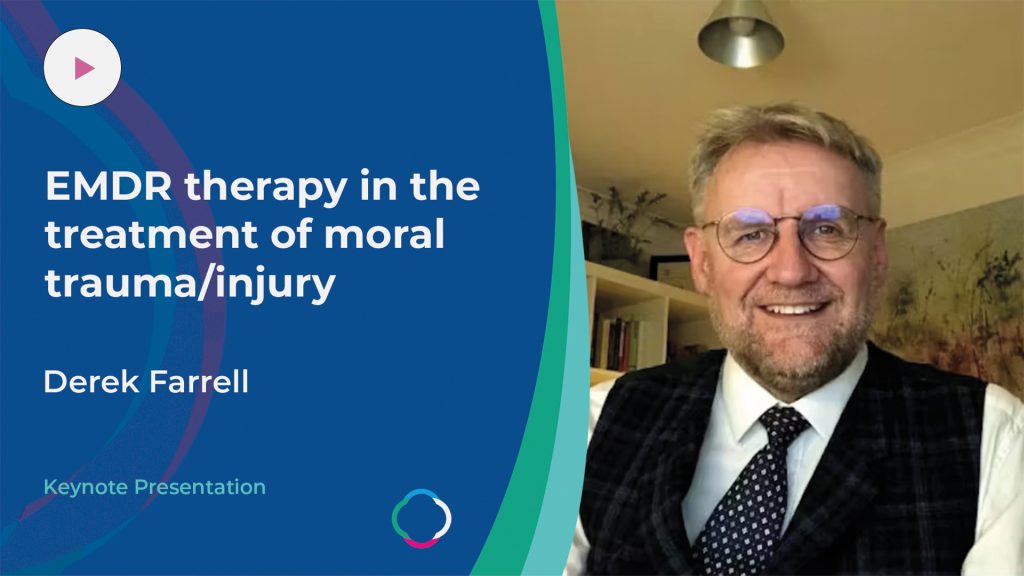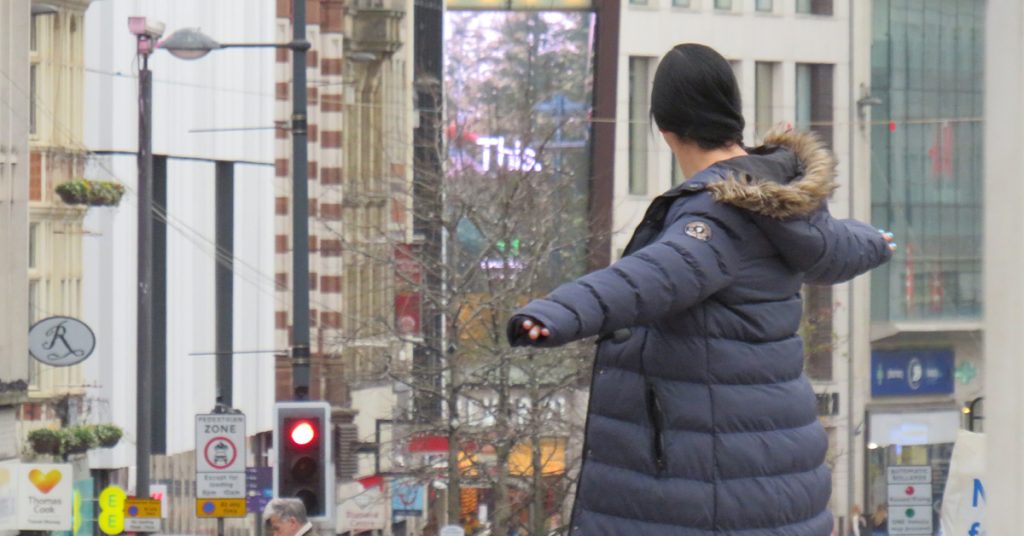Appeasement: replacing Stockholm syndrome as a definition of a survival strategy

Stockholm syndrome or traumatic bonding (Painter & Dutton, Patterns of emotional bonding in battered women: Traumatic bonding. International Journal of Women’s Studies, 8(4), 363–375, 1985) has been used in mainstream culture, legal, and some clinical settings to describe a hypothetical phenomenon of trauma survivors developing powerful emotional attachments to their abuser.
It has frequently been used to explain the reported ‘positive bond’ between some kidnap victims and their captor’s, although scarce empirical research has supported this assertion. It has been used in various situations where interpersonal violence and mind control are reported and where clear power differentials exist, such as in child sexual abuse, intimate partner violence, human trafficking, and hostage situation scenarios.
Critique of Stockholm syndrome Words can carry strong messages about intentionality, motivation, and healing. Consider the recent aware-ness around the use of victim versus survivor. Some people choose to use the word victim when describing life-threatening traumatic experiences, while others prefer the word survivor, warrior, or victor. What is important is that individuals who have experienced these traumas have a voice in how they refer to them-selves and that the words we use accurately reflect their lived experiences.
One particularly problematic term for survivors of kidnapping, as well as trafficking, interpersonal vio-lence, and sexual abuse is ‘Stockholm syndrome’. Stockholm syndrome was originally proposed when trying to explain why some survivors of hostage-type situations do not, to the outside observer, appear to react to their situation with fight or flight, and further-more seem to sympathise with their perpetrator as supposedly evidenced by lack of cooperation with police, and expression of understanding or lack of expression of hostility toward their perpetrator. The term has since been used in other traumatic situations in which there are power imbalances such as kidnap-ping, and abusive relationships. The word Stockholm syndrome postulates a positive emotional relationship between victims and abusers that developed because of the trauma (Jülich, 2005). This term persists despite several critiques.
First, Stockholm syndrome has been interpreted to assume that there is a relationship between perpetrator and victim that reflects mutual care and affection between them, but that mutuality does not exist in cases of abduction, abuse, and perceived life threat (Graham et al., 1988). Furthermore, Stockholm syn-drome attempts to explain survival from captivity as a formula derived from the perpetrator or observer’s perspective (Namnyak et al., 2008). The variables include: the perceived threat to survival; the belief the threat will be carried out; the captive perceives some small kindness from the captor; and the hostage experiences the perceived inability to escape. Each of these perspectives requires a level of conscious proces-sing that contradicts what occurs physiologically during a terror state. These conceptual difficulties with Stockholm syndrome may explain why a review of the professional literature on survival techniques utilised during violent crimes (Jordan, 2013) demon-strates a lack of validated criteria for Stockholm syn-drome as a psychiatric diagnosis along with a limited empirical research base (Geisler et al., 2013). The con-cept’s origin in the media rather than research or clini-cal practice and its application to various crimes, ages, and interpersonal contexts raise questions about its meaning, validity, and continued relevance to theory building and research (Namnyak et al., 2008).


Although past theorists have suggested that the concept of Stockholm syndrome may help normalise survivors’ behaviour (Graham et al., 1988), it can be argued that the term does not reflect survivor experi-ence, a critique not yet reported in the professional lit-erature. A more accurate term would be ‘appeasement’ because the word and overall description of appease-ment emphasise the asymmetry in the relationship and the adaptive strategy to regulate and calm the cap-tor, thus minimising potential injury and abuse to the victim (Treisman, 2004).
Using the Polyvagal Theory’s (Porges, 2011) asser-tion of the fundamental drive to internalise a sense of safety through sociality (Porges, 2022), we propose that the term appeasement may be operationally defined to more accurately describe a powerful instinctual strategy to survive and thrive regardless of the circumstances that can be separated from the concept of mutual affection and bonding with the per-petrator. This perspective can be applied to a variety of populations where the power differential and basic survival needs perpetuate abuse and victimisation regardless of the previous relationship with the perpetrator.
A brief history of appeasement as a response to threat
Cantor and Price (2007) introduced the concept of appeasement, proposing that it is a natural mamma-lian response to entrapment or confinement. They suggested that appeasement could contribute to a bet-ter understanding of PTSD, Stockholm syndrome, and hostage dynamics. They proposed a step in articulat-ing the normalisation of a shutdown process and suggested implications for further understanding of victim dynamics. From their perspective, appeasement was a pacification and submission response. Since appeasement may serve to de-escalate a situation, it was suggested that the resulting pacification could contribute to survival. Although we reject the definition of Stockholm syndrome, Cantor and Prices’ appeasement concept helps operationalise dynamics present in circumstances where a victim perceives and experiences threat to physical and psychological survival, especially when there is social isolation.
However, the Cantor and Price formulation of appeasement misses the two-way functional inter-action, with the beneficial neurobiological impact of co-regulation, between perpetrator and victim that is better understood in defining appeasement through the Polyvagal Theory. The Polyvagal Theory (Porges, 2004, 2021, 2022) suggests that when faced with a life threat the foundational survival circuits originat-ing in the brainstem, which regulate bodily organs via the autonomic nervous system, take over moving the nervous system into a defensive state that sup-plants intentional behaviour and social interactions. This process is observed as a variation of the cascade of fight/flight/freeze and potentially collapse and shut-down. This defensive cascade is dependent on auto-nomic states that functionally divert neural activity from higher brain structure resulting in reducing pro-blem-solving capacity, limiting cognitive processing, and displacing intentionality and authentic forms of sociality with defensive strategies. Basic survival needs can determine and impact an individual’s definition of life threat. For example, a parent facing housing and food insecurity can experience a lack of resources as a life threat. Social connection to the per-petrator may be experienced as a type of lifeline.
Dissociation is a product of these foundational sur-vival-oriented brainstem circuits and may serve as a buffer to the realisation that one’s life is at risk. From the polyvagal perspective, dissociation is viewed as an unconscious process that serves as a protective buffer when a threat is imminent. When an individual dissociates, their higher level of thinking is disrupted and the autonomic functions of the nervous system take over to optimise the regulation of bodily systems via the autonomic nervous system, even during life-challenging situations. Heart rate is slowed, digestion is interfered with, and awareness is impacted. Individ-uals who have suffered a traumatic (life-threatening experience) may internalise a feeling of extreme vul-nerability and may have difficulty moving out of the dissociative state (Cantor & Price, 2007). From a pure survival stance, the slowing of heart rate, diges-tion interference, and impaired reality perception serves to save resources and protect from panic. Although these strategies of conservation are evolutio-narily effective in asocial reptiles, they compromise homeostatic functions and sociality for humans. It is later, after the imminent threat has passed, that con-tinued dissociation can become problematic, resulting in an array of mental and physical health comorbid-ities. By accepting the preeminent need to survive as a biological imperative, then disassociation could be studied as an adaptive survival-related physiological buffer in response to overwhelming circumstances. In extended periods of captivity or when under threat, an individual may function in a disassociated state, allowing for a tolerance of the intolerable.
A science of safety leads to an understanding of the internal processes supporting survival
The motivation to feel safe is a primary goal of the ner-vous system (Porges, 2022). The Polyvagal Theory (Porges, 2021) provides an innovative scientific per-spective that includes the neurophysiological descrip-tion of the neural circuit that down-regulates threat reactions. This physiological adjustment occurred during the evolutionary shift from asocial reptiles to social mammals (Porges, 2021). From the perspective of evolution, the shift in the autonomic nervous sys-tem is at the core of our ability to connect socially with others. When we apply and refine the concept of appeasement to the Polyvagal Theory’s assertion of the fundamental drive to internalise a sense of safety, we can more accurately describe the powerful instinctual desire to survive and thrive, regardless of the circumstances. In this context, the concept of appeasement eliminates most suggestions of mutual affection and bonding when in survival mode. The importance of feeling safe as an objective feeling has been debated going back to the earliest psychologists, such as Wundt (Ogden, 1907).
The ambiguous language used to describe emotions and feelings adds to the challenge of operationalising a ‘felt sense of safety’ (Porges, 2022). Polyvagal Theory suggests a definition of resilience in victims/survivors that conceptualises a hierarchical explanation of feel-ings as higher brain interpretations of the neural sig-nals conveying information regarding visceral organs (e.g. heart, gut, etc.) to the brainstem (Geisler et al., 2013). This bio-psycho-evolutionary perspective emphasises the foundational function of the auto-nomic state in the subjective experiences of global feel-ings and specific emotions. Within this hierarchical conceptualisation, feelings of safety are preeminent and form the core of an enduring motivational system that shifts autonomic state, which in turn drives beha-viours, emotions, and thoughts.
When faced with a physical threat, the natural response is to revert to a defensive stance, including fight/flight or a complete shutdown of emotional responses (Porges, 2022). Faced with a situation where no escape is immediately possible, some survi-vors may have the resource to express a type of ‘super social engagement’ that may enable them to engage and effectively co-regulate and calm their per-petrator. We operationally define this capacity to co-regulate and calm the perpetrator as appeasement. The ability to access the appeasement process is con-ceptualised as a type of ‘super social engagement’ that requires the neural capacity to manage a hybrid state that enables access to the calming and social cuing of the social engagement system (Porges, 2011, 2021, 2022), while simultaneously maintaining access to the energetic mobilisation sympathetic system to engage fight/flight behaviours if necessary (Porges, 2011). Firsthand accounts from survivors of abduction underscore their awareness of the importance of estab-lishing some type of social connection with the perpe-trator. Repeated themes of awareness of the need for the establishment of connection are brought into therapeutic settings and are described by these survi-vors. In the terms used within Polyvagal Theory, this process of connection between the survivor and the perpetrator is considered ‘co-regulation,’ a process through which there is a mutually beneficial bi-direc-tional expression of cues of safety that functionally calm the autonomic nervous system and observable behaviour (Mohandie, 2002).
Not only does social engagement help calm the autonomic nervous system, the withdrawal of this social engagement can dysregulate the system. This may necessitate a continued need for social engage-ment in order for the survivor to stay safe. In a study on co-regulation between mothers and infants, the caregiver of young children provides cues to calm infants. Specifically, prosodic tone was demon-strated to help regulate a baby who is having behav-ioural distress. Furthermore, the infants appeared distressed after social engagement was withdrawn from their caregiver. This particular study not only focused on the impact of prosodic tone on the infants’ internal stress, it also presents the dis-regularity impact of social withdrawal, suggesting the bio-direc-tional impact between two autonomic nervous sys-tems (Sarrate-Costa et al., 2022).
The ability to appease when in an activated state requires sufficient regulation to appear to the perpe-trator as being calm. This form of regulation is not easily accessed or universally available but requires innate abilities to resources to inhibit the sympathetic arousal that would trigger the perpetrator’s defense. Appearing calm and sending cues of engagement when faced with a predator provides an opportunity for co-regulation to occur. The visceral response to threat is a foundational survival circuit located in the brainstem and shared by several vertebrate species that preceded the evolution of social mammals. These circuits coordinate sympathetic arousal or dorsal vagal shut down to support survival via defen-sive behaviours. The ability to be in the proximity of a life-threatening individual or event, without shutting down, fleeing, or fighting, requires the ability to access the social engagement system with its neurophysiolo-gical dependence on the ventral vagal complex that regulates primary structures (e.g. facial expression, the intonation of voice) upon which social connection and co-regulation are dependent (Porges, 2022). Acti-vating the neural substrate to appease is a challenge to the nervous system and is not an easily accessible intentional behaviour. Rather, it requires a retuning of the autonomic state that opportunistically main-tains sufficient inhibition over the adaptive threat reactions of the sympathetic nervous system (i.e. fight/flight) or the dorsal vagal system (i.e. shutdown, collapse, fainting, defecation). By placing an auto-nomic state at the core of feelings of safety or threat, the pragmatic survival behaviours of fight and flight and complex problem-solving strategies that would lead to escape are consequential and dependent on the facilitatory function of the autonomic nervous sys-tem in optimising these strategies. Similarly, turning off the threat reactions and calming the autonomic state via the ventral vagal pathway will promote inter-personal accessibility, while simultaneously support-ing the co-regulation of the autonomic states of both the survivor and the perpetrator. This model positions the autonomic state as an intervening variable, med-iating the interpretation of contextual cues and shap-ing the reactions of both predator and captive. Within this conceptualisation, depending on the indi-vidual’s autonomic state, the same contextual cues and challenges may result in different behavioural, cogni-tive, and physiological reactions. This would be true both within and between individuals.
Appeasement is a powerful utility for survival, adaptability, and resilience
There is a range of responses among individuals who share the same traumatic environmental context. Studies on hostages indicate that a calm, regulated state may increase survival rates (Jaeger et al., 2014). Furthermore, the adaptive utility of appeasement in the experiences of survivors of abuse may functionally neutralise defensive strategies in the victim as well as the perpetrator via neural circuits communicating cues of safety. Thus, if the perpetrator starts to feel safe with the victim, then there is the possibility of the perpetrator’s nervous system calming and receiv-ing cues of safety emitted by the victim, resulting in less violence, anger, and injury. This is not to be con-fused with the notion of fawning. Fawning is the use of people-pleasing to diffuse conflict and earn the approval of others (The Association between a Psy-chotherapist’s Theoretical Orientation and Perception of Complex Trauma and Repressed Anger in the Fawn Response – ProQuest, n.d.). It’s a maladaptive way of creating safety in our connections with others by essentially mirroring the imagined expectations and desires of other people.
We propose that the victim is not using fawning tech-niques, but is indeed influencing the perpetrator by an internal process of co-regulation (Porges, 2004). Co-regulation encourages regulation of both captor and abductee. It is a feature that enables all mammals to downregulate defensive strategies like yelling and screaming and instead promotes sociality by enabling psychological and physical proximity without the consequences of injury, even in survival situations. It is this calming mechanism that adaptively adjusts to protect us when in fight-or-flight mode (Geisler et al., 2013). This message has been confused by some as Stockholm syndrome or as a type of affection instead of a powerful adaptive survival reaction. In fact, fawning does not use the powerful biological forces of co-regulation. Fawning involves less attune-ment and is more one sided. In addition, from a poly-vagal perspective, fawning may have the opposite effect of appeasement because it could be perceived by the aggressor as a highly vulnerable st Bonanno and colleagues’ research (Bonanno & Burton, 2013) builds on the growing body of literature that underscores the acceptance that the fluid process of the nervous system and self-regulation has become an important variable for understanding the resiliency (Bonanno, 2021; Chen & Bonanno, 2020; Jiang et al., 2021). In summary, the first step of self-regulation is an assessment of what is required in the specific scen-ario. The second step, according to Bonannos’ theory, is the choice of what they describe as a regulatory response. The question becomes, what can I do?Lastly, the question becomes, is it working? The last question requires a conscious assessment of the strat-egy. It may be assumed that in a life-or-death situ-ation, the question becomes, how likely am I to be kept alive? This research supports the notion that the nervous system, especially brain structures involved in regulating intentional behaviour, plays an important role in survival. However, from a bio-logical perspective, what is missing is the understand-ing of the role that foundational brainstem survival mechanisms play in response to imminent danger. It is also unclear how one develops a resilient enough autonomic state to be able to have an appeasement response in the face of that threat.
It is well documented that conscious thought is impacted by the biological response to terror (Pyszc-zynski et al., 1999). In times of life threat, the founda-tional survival circuits in our nervous system take over and interfere with executive functioning, suggesting that logical thought and strategy development are fully unconscious processes. All mammals operate from the perspective of safety versus vulnerability. A flexible nervous system provides options for survival and resilience, although these actions may be the result of unconscious processes. Animal models have also presented data to support that all mammals reach a level of saturation in which the threshold is too high for one nervous system to influence the other without rest and deactivation (Chemtob et al., 1992). This is important when understanding resilience because, in many situations, the fate of the victim is, of course, predicated by the pathology or motivation of the perpetrator.
Clinical implications
Treating trauma victims/survivors is not a one size fits all process. There are numerous treatment approaches, many supported by robust evidence-based research (Han et al., 2021; MacFarlane & Kaplan, 2012; Review of Narrative Therapy: Research and Utility – Mary Etchison, David M. Kleist, 2000, n.d.; Warshaw et al., 2013; Williamson et al., 2010). The common variable across modalities is the adaptive nervous system of the individual trying to make sense of the horrific past. The question initially is ‘why didn’t you leave?’ but a more important question is ‘ how did you survive?’ The clinical focus should sup-port the natural instinctual process that kept the indi-vidual alive. Post recovery, the challenge becomes how to help support the internalisation and the realisation that there is no longer danger and life threat. There lies the dilemma, victim/survivors of long-term and isola-tive abuse seen in kidnapping and interpersonal vio-lence are often led to believe there will always be danger and life threat even when the perpetrator is not present. Fear immobilises and compromises higher level processing re-enforcing dependency.
The belief that one fell in love with the perpetrator can be confusing and frightening to an individual who has experienced captivity. The concern can lead to fears of further vulnerability and may connote the message that the individual is capable of being easily fooled. Another factor is the message given to family members that the individual intentionally did not escape out of a twisted allegiance to the perpetrator. This message is also confusing and dysregulating to family members and supporters, which can prevent the family members from being actively supportive of the survivor. Perception of support is important to the healing and well-being of the whole family sys-tem (Bailey et al., 2020). To begin to receive and give this support, it is important for survivors and their families to understand that kidnapping, trafficking and intimate partner violence by definition occur in contexts of differentials. Captivity in these circum-stances can be easily confused with love as survival needs shape dependency in the same way a small child is forced to depend on the caregiver.
Finally, shame has been identified as one of the key factors underlying many trauma symptoms (López-Castro et al., 2019; Saraiya & Lopez-Castro, 2016). Ideas such as Stockholm syndrome can increase shame. Providing survivors with the appeasement fra-mework normalises and commends the survival mechanism given the rare capacity to engage the social network when under threat. Appeasement can and should be framed as an alternate explanation for what may be a strong survival tactic, a tactic not solely intentional, but dependent on the capacities of a resi-lient autonomic state as a resource.
and variables contributing to effective therapeutic interventions (Geller & Porges, 2014; Porges & Dana, 2018). When this theory is applied to circum-stances involving captivity and life threat, it provides a plausible explanation of how we can understand and honour the survivors who have had a regulated nervous system that when confronted with life threats enable them to express features of calmness, interest, and social engagement. Thus, possibly diffusing or altering the agitated state of the perpetrator. As a caveat, the model is solely explanatory to honour the capacity of the survivors who have had the resource to access appeasement during life-threatening situ-ations. The model does not infer that this capacity can be learned or trained. Further research should include the impact of operationalising this concept in a manner that supports the healing and well-being of survivors of a variety of crimes. An important research question should be: ‘If survivors behaviour is supported as a resiliency factor and labelled in terms that underscore unconscious processes, will it impact the recovery process in a positive manner if their experience is conceptualised from their perspective and not that of the preparator?’
Disclosure statement
No potential conflict of interest was reported by the author(s).


Rebecca Bailey, Jaycee Dugard, Stefanie F. Smith & Stephen W. Porges














